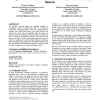Free Online Productivity Tools
i2Speak
i2Symbol
i2OCR
iTex2Img
iWeb2Print
iWeb2Shot
i2Type
iPdf2Split
iPdf2Merge
i2Bopomofo
i2Arabic
i2Style
i2Image
i2PDF
iLatex2Rtf
Sci2ools
GECCO
2008
Springer
2008
Springer
Using quotient graphs to model neutrality in evolutionary search
We introduce quotient graphs for modeling neutrality in evolutionary search. We demonstrate that for a variety of evolutionary computing problems, search can be characterized by grouping genes with similar fitness and search behavior into quotient sets. These sets can potentially reduce the degrees of freedom needed for modeling evolutionary behavior without any loss of accuracy in such models. Quotients sets, which are also shown to be Markov models, aid in understanding the nature of search. We explain how to calculate Fitness Distance Correlation (FDC) through quotient graphs, and why different problems can have the same FDC but have different dynamics. Quotient models also allow visualization of correlated evolutionary drives. Categories and Subject Descriptors I.2.m.c [Computing Methodologies]: Artificial Intelligence – Miscellaneous - Evolutionary computing and genetic algorithms. General Terms Theory, Measurement. Keywords Quotient sets, Degenerate Code, Fitness Distance Corr...
| Added | 09 Nov 2010 |
| Updated | 09 Nov 2010 |
| Type | Conference |
| Year | 2008 |
| Where | GECCO |
| Authors | Dominic Wilson, Devinder Kaur |
Comments (0)

